In today’s digital age, building a personal brand is more vital than ever. As we head into 2025, professionals are discovering that a standout website is no longer optional—it’s a must-have asset for career growth and visibility.
This article spotlights eight inspiring personal brand website examples that truly set the bar for innovation, strategy, and real-world results in 2025. Each example brings something unique to the table, from bold designs to clever conversion tactics.
Get ready to explore a variety of website styles, uncover their core features, and gather practical tips you can use to elevate your own online presence. Let these bold examples spark ideas and motivate you to take your personal brand to the next level.
Why Personal Brand Websites Matter in 2025
In 2025, a personal brand website is more than just a digital business card. It is your professional command center, giving you the freedom to shape your story, showcase your expertise, and connect with clients or employers on your terms. Let’s dig into why personal brand website examples are taking center stage this year.
The Shift from Social Profiles to Owned Platforms
Many professionals once relied solely on LinkedIn, Behance, or other social platforms to showcase their work. But as algorithms change and audiences become more fragmented, these channels now feel limiting. With social profiles, you’re always playing by someone else’s rules.
A personal brand website gives you total control over your message, visuals, and even how visitors interact with your content. Unlike social networks, you can highlight your full portfolio, integrate lead forms, and optimize for search engines. Recent trends show employers and clients increasingly prefer reviewing personal brand website examples over static social profiles, as websites allow for richer storytelling and stronger SEO presence. According to Personal Branding Trends for 2025, there’s a clear industry shift toward owned platforms, immersive visuals, and direct audience engagement.
Benefits of a Strong Personal Brand Website
A well-crafted personal brand website builds instant credibility and trust. When potential clients or employers land on your site, they see your unique skills, achievements, and personality all in one place.
The top personal brand website examples feature clear calls to action, robust testimonials, and easy ways to connect. These sites improve your discoverability through SEO, helping you appear in search results for relevant terms in your industry. Even better, a personal brand website enables direct lead generation through forms, scheduling tools, or digital product sales. With ownership over your platform, you’re not at the mercy of changing social algorithms.
Who Can Benefit Most from a Personal Brand Website
Personal brand website examples are particularly valuable for digital marketers, web developers, designers, writers, consultants, and entrepreneurs. If you want to stand out in a crowded market, your own website is essential.
Take Gary Vaynerchuk, whose site integrates business ventures and personal branding, or Alex Cattoni, who uses her platform to attract aspiring copywriters. Designers like Muazzim showcase portfolios with interactive visuals and clear service offerings. Even agencies and brands are now leveraging personal websites to grow their reach and authority. If you offer services, sell products, or want to build a loyal audience, a personal brand website is your edge.
Key Trends in 2025 Personal Brand Websites
Looking at the latest personal brand website examples, several trends define 2025:
- Mobile optimization and lightning-fast load times
- Immersive visuals and video integration
- Personalized storytelling and interactive features
- Automation tools and lead magnets to capture new business
Staying ahead of these trends ensures your website makes a lasting impression, drives results, and reflects your evolving brand.
8 Inspiring Personal Brand Website Examples for 2025
A new era of personal brand website examples is setting the standard for digital presence in 2025. These sites are more than portfolios—they blend interactive design, storytelling, and conversion-driven features to help professionals stand out. Let’s explore eight personal brand website examples that show what’s possible when creativity meets strategy.
Alex Cattoni
Alex Cattoni’s site is a masterclass in using personal brand website examples to drive business growth. The homepage greets you with vibrant colors, energetic copy, and a confident photo, immediately showcasing her expertise as a conversion copywriter.
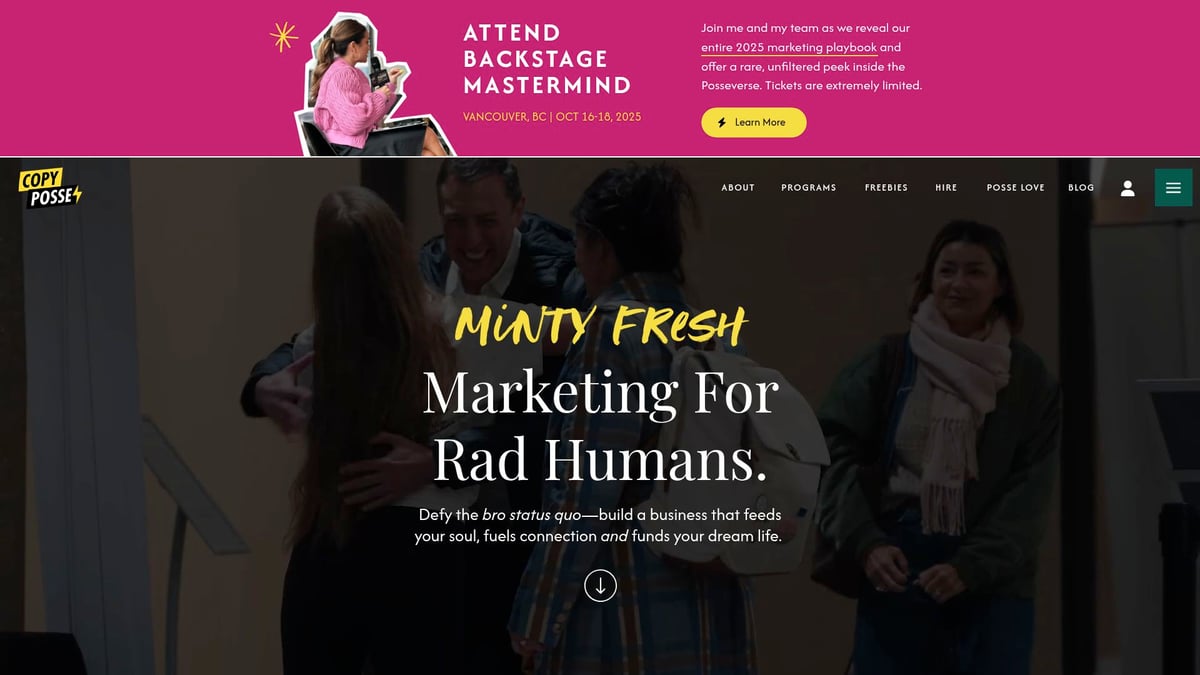
Core features include:
- Engaging, personality-driven copy that mirrors her brand voice.
- Conversion-optimized CTAs guiding visitors to free resources and services.
- A detailed “About” section and prominent testimonials.
- Client logos and social proof throughout.
These elements build trust and highlight her achievements, making this one of the most effective personal brand website examples for lead generation. Alex’s site is designed to funnel visitors toward coaching and copywriting services, using storytelling and relatable language. For aspiring copywriters and entrepreneurs, her site demonstrates how a strong digital presence can accelerate growth.
Pros:
- Authentic, approachable voice.
- Clear service offerings and strong CTAs.
- Excellent use of personal branding.
Cons:
- Portfolio samples are limited.
- Some users may find the information density overwhelming.
Unique selling points:
- Balances business goals with personal storytelling.
- Leverages achievements to build authority.
If you’re seeking actionable ideas, Alex’s approach aligns closely with proven website lead generation strategy principles. Her site is a top-tier example for anyone looking to optimize their own personal brand website examples.
Bruno Simon
Bruno Simon’s personal brand website examples break the mold with immersive, interactive design. Visitors are welcomed by a playful 3D homepage where you drive a virtual car to explore content, blending fun with advanced web development skills.

Core features:
- 3D interactive homepage and gamified navigation.
- Portfolio showcase that highlights creative projects.
- Contact section and smooth transitions.
The site’s unique approach demonstrates technical prowess and creativity, making it memorable for recruiters and agencies. These personal brand website examples prove that interactivity can set you apart in tech fields.
Pros:
- Highly engaging and creative.
- Demonstrates advanced technical skills.
- Unique user experience.
Cons:
- Navigation may be tricky for some users.
- Performance can vary on older devices.
Unique selling points:
- Playable elements for user engagement.
- Strong storytelling through design.
Bruno’s personal brand website examples show how interactivity and innovation can elevate your professional image.
Muazzim
Muazzim’s site is a shining example of clean, high-converting personal brand website examples for designers. The homepage uses optimal white space, a prominent personal photo, and conversion-focused CTAs to draw visitors in.
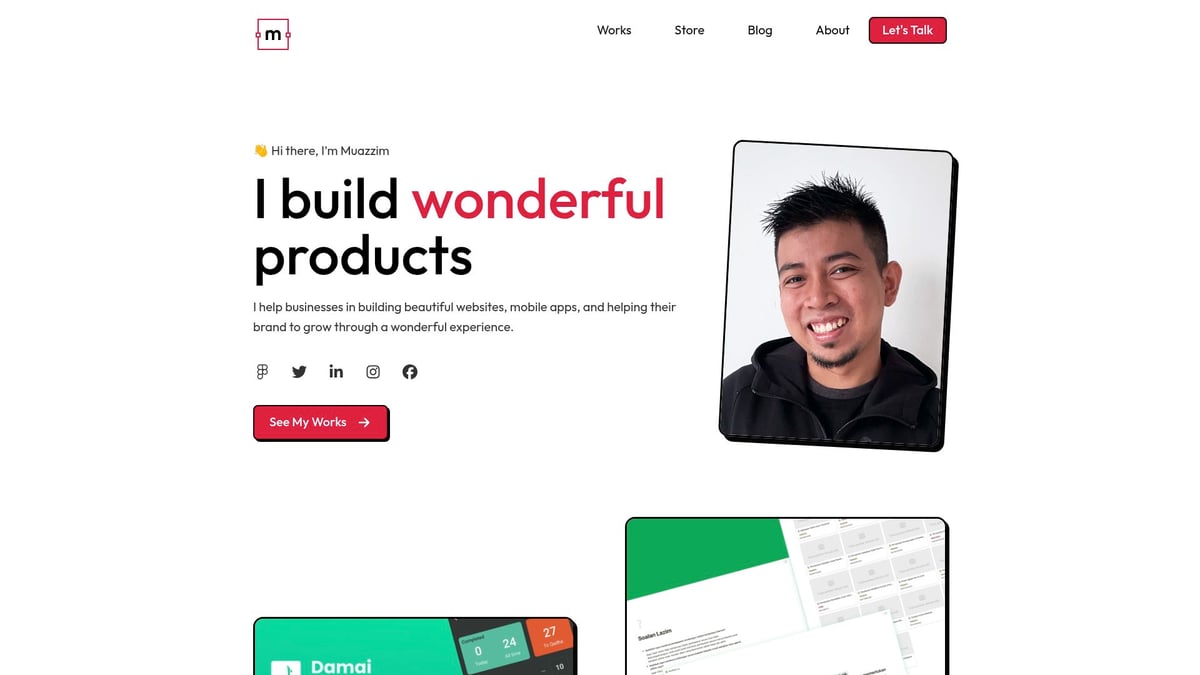
Core features:
- Clean UI/UX with clear value proposition.
- Integrated portfolio and vector design samples.
- SEO-friendly structure for better discoverability.
Businesses, startups, and product companies seeking UI/UX expertise will appreciate how these personal brand website examples showcase skills and personality. The site’s layout maximizes conversions with visual hierarchy and easy navigation.
Pros:
- Strong branding and visual balance.
- Effective use of white space and SEO.
- High-converting call to action.
Cons:
- Limited details about full services.
- Navigation could be expanded.
Unique selling points:
- Visual gazing to guide visitor attention.
- Balanced, conversion-driven design.
Muazzim’s personal brand website examples are ideal for professionals who want a sleek, results-oriented online presence.
Gary Vaynerchuk
Gary Vaynerchuk’s website is a centerpiece among personal brand website examples, functioning as a hub for his ventures, content, and community. The site’s consistent branding, seamless integration of podcasts, videos, and events, and robust social links make it a powerhouse.
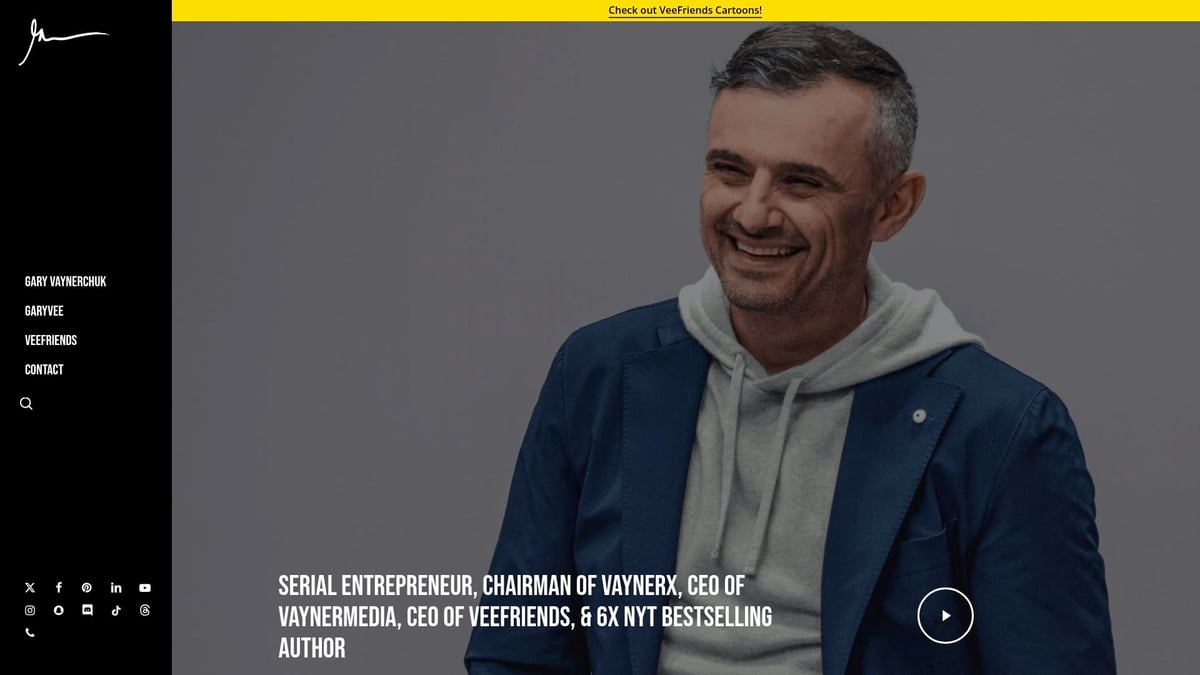
Core features:
- Multi-business integration under one personal brand.
- Smooth transitions and clear navigation across resources.
- Authority-building content including podcasts, videos, and event listings.
This platform centralizes personal and business brands, making it easy for entrepreneurs, marketers, and fans to connect with Gary’s work. Among personal brand website examples, his stands out for its reach and authority.
Pros:
- Strong, consistent branding.
- Rich resources and cross-promotion.
- Authority positioning.
Cons:
- Navigation can be overwhelming for new visitors.
- Content density may distract some users.
Unique selling points:
- Brand color consistency throughout.
- Seamless internal linking.
Gary’s personal brand website examples demonstrate how to scale your brand while maintaining clarity and trust.
Karl Myrvang
Karl Myrvang’s site showcases the power of minimalism in personal brand website examples. The homepage offers a concise introduction, skills summary, and immediate value proposition, all optimized for speed and clarity.
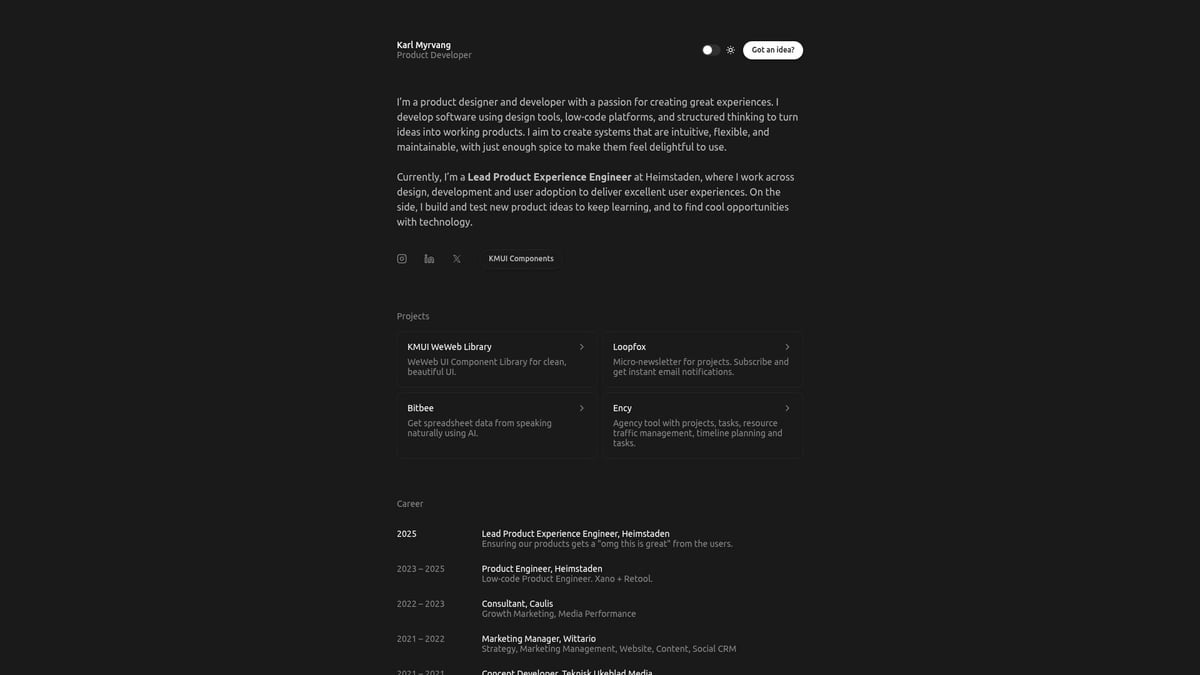
Core features:
- Minimalist, desktop-first design.
- Fast load times and mobile responsiveness.
- Clear contact information and straightforward navigation.
This approach appeals to employers and recruiters who want information quickly. Among personal brand website examples, Karl’s is a reminder that less can be more.
Pros:
- Fast and user-friendly.
- Easy to navigate.
- Effective for job seeking.
Cons:
- Limited imagery may feel sparse.
- Project details could be expanded.
Unique selling points:
- Performance focus for instant information.
- Minimalism that still conveys expertise.
Karl’s personal brand website examples are perfect for developers and professionals who value simplicity and efficiency.
Jay Baer
Jay Baer’s site exemplifies authority in personal brand website examples, using personality-driven visuals and social proof to establish trust. The homepage features a bold banner, embedded testimonials, and clear service pathways.
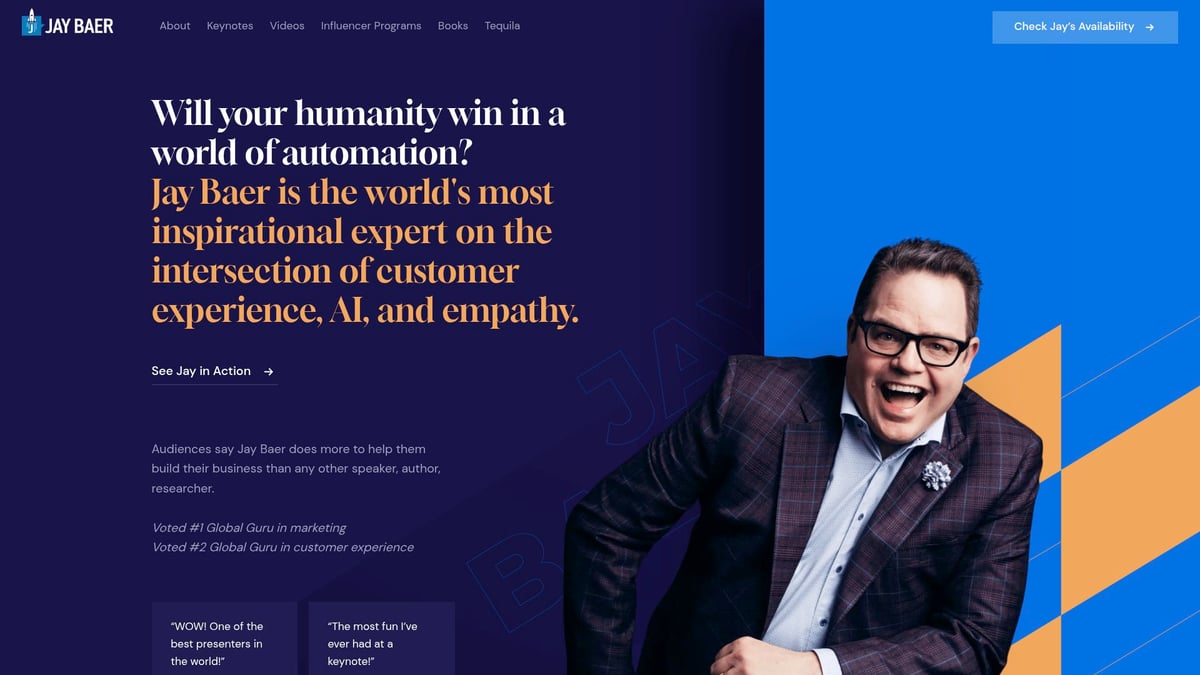
Core features:
- Authority-building CTAs and client testimonials.
- Detailed service descriptions and social proof.
- Personality mirroring in visuals and copy.
Businesses and event organizers will find these personal brand website examples effective for growth consulting and speaking engagements. Jay’s site makes it easy to connect, with clear contact options and service details.
Pros:
- Strong authority signals.
- Prominent testimonials.
- Clear navigation to services.
Cons:
- Social links in the footer may reduce visibility.
- Navigation could be improved.
Unique selling points:
- Authority CTA to drive engagement.
- Testimonial prominence.
Jay Baer’s personal brand website examples highlight the value of credibility and clear communication.
Neil Patel
Neil Patel’s platform stands out among personal brand website examples for its SEO-optimized structure and educational focus. The site is packed with free tools, lead magnets, and value-driven resources for marketers and business owners.
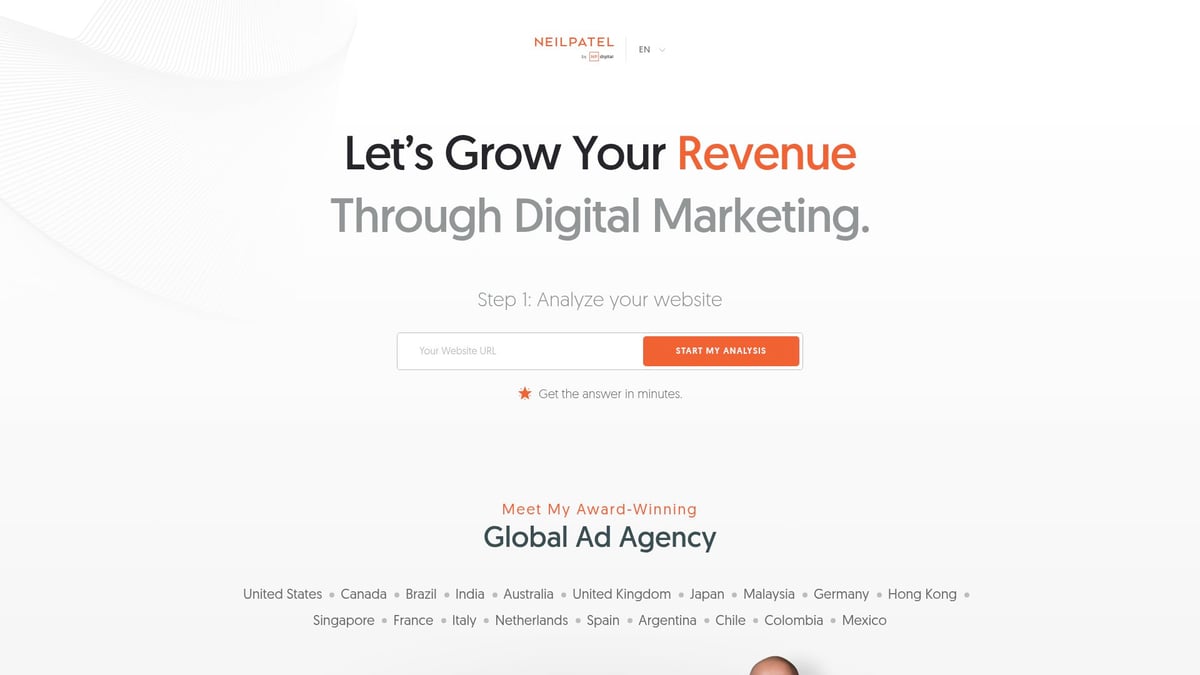
Core features:
- Prominent “About” section and white space utilization.
- Lead magnets for email capture.
- Educational resources and blog for authority building.
The site’s layout and copy position Neil as a thought leader, driving leads and providing actionable insights. These personal brand website examples are ideal for those seeking to combine SEO with personal branding.
Pros:
- Strong search engine optimization.
- Valuable free tools and resources.
- Clear calls to action.
Cons:
- May feel commercial to some users.
- Heavy emphasis on lead generation.
Unique selling points:
- Visual gazing and design psychology.
- Educational, value-first approach.
Neil’s personal brand website examples show how to blend expertise, SEO, and conversion strategies.
Rubens Cantun
Rubens Cantun’s site is one of the most creative personal brand website examples, blending a bold color palette with digital product sales. The homepage features a sticky header, responsive design, and rapid information delivery.
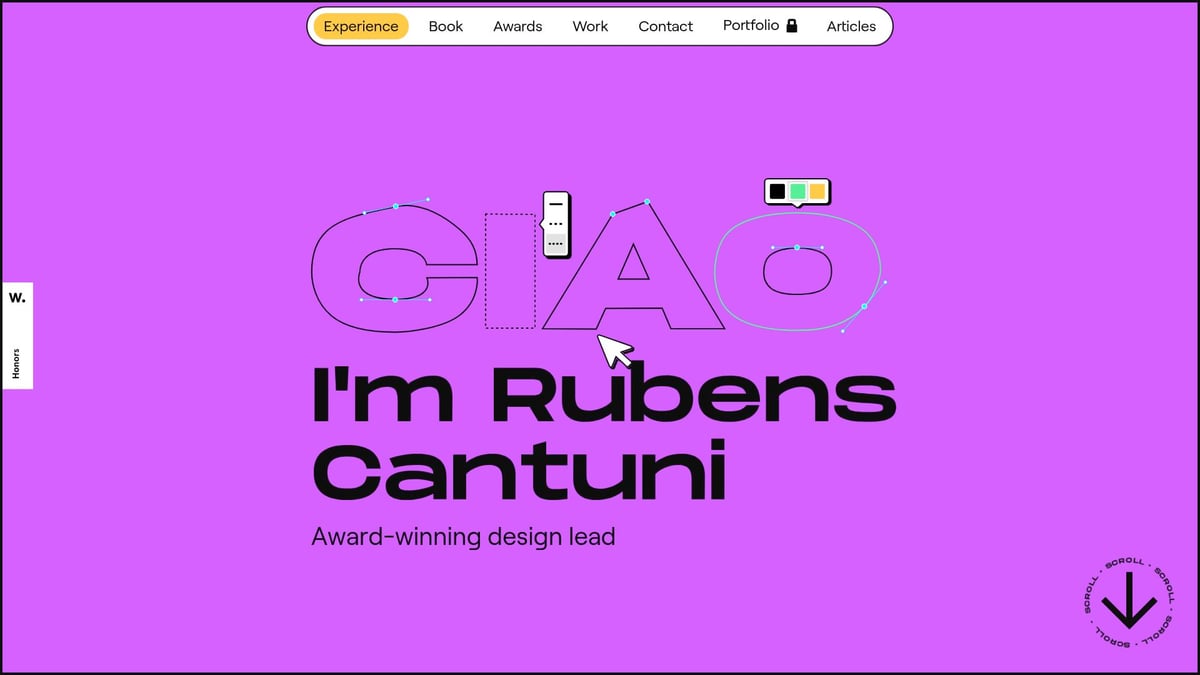
Core features:
- Creative, vibrant visuals reflecting personality.
- Integration of ebook sales and digital products.
- User-friendly navigation and clear information hierarchy.
Design clients and fellow creatives will appreciate how these personal brand website examples enable monetization and audience engagement. The site’s digital product integration adds an extra revenue stream.
Pros:
- Fun, engaging design.
- Additional income through digital products.
- Clear structure and navigation.
Cons:
- Service details are limited.
- Font choices may not suit all users.
Unique selling points:
- Header navigation and color creativity.
- Monetization through digital products.
Rubens Cantun’s personal brand website examples are perfect for creatives who want to showcase skills and generate passive income.
Comparison Table: Personal Brand Website Examples
| Name | Best For | Core Feature | Unique Element |
|---|---|---|---|
| Alex Cattoni | Copywriters, Coaches | Conversion CTAs | Storytelling, lead gen focus |
| Bruno Simon | Developers, Agencies | 3D Interactivity | Gamified navigation |
| Muazzim | UI/UX Designers | Clean, SEO structure | Visual gazing for conversion |
| Gary Vaynerchuk | Entrepreneurs | Multi-brand integration | Brand consistency |
| Karl Myrvang | Job Seekers | Minimalism, speed | Immediate value proposition |
| Jay Baer | Consultants | Testimonials, authority | Authority CTA |
| Neil Patel | Marketers | SEO, free tools | Educational value |
| Rubens Cantun | Creatives | Digital product sales | Color creativity, ebook sales |
From interactive experiences to minimalist layouts, these personal brand website examples offer inspiration for every professional. Use their strategies to guide your own site’s evolution in 2025.
Essential Elements of High-Converting Personal Brand Websites
Creating a high-impact personal brand website is about more than just a pretty design. The best personal brand website examples share essential elements that help you stand out, build trust, and drive meaningful action.
Crafting a Compelling Personal Brand Statement
A strong personal brand statement is the heartbeat of successful personal brand website examples. This concise message should instantly answer who you are, what you do, and who you serve.
For instance, Louise Henry’s homepage features a direct pitch and a professional photo, making her value clear at a glance. According to Personal Branding Statistics 2025, websites with clear statements above the fold see a notable boost in engagement and conversions.
Tips for your statement:
- Keep it short: “I help [audience] achieve [result] by [method].”
- Place it at the top of your homepage.
- Match your tone to your brand’s personality.
Personal brand website examples with crisp statements make a lasting first impression.
Using Visuals and Design Psychology
The most effective personal brand website examples use visuals strategically to guide visitor focus and create trust.
Direct eye contact in profile photos, seen on Neil Patel and Muazzim’s sites, encourages engagement. Color psychology is also key: Rubens Cantun’s vibrant palette reflects his creative energy, while Gary Vaynerchuk uses consistent brand colors for recognition.
Other best practices include:
- Ample white space for readability and focus.
- Visual hierarchy to highlight key info.
- Consistent imagery and fonts for a cohesive look.
Applying these design psychology principles helps your personal brand website examples feel both professional and approachable.
Integrating Social Proof and Testimonials
Trust is everything online, and the top personal brand website examples leverage testimonials and social proof to build credibility.
Jay Baer and Alex Cattoni’s websites feature glowing client reviews and embedded case studies. Prominent placement—like banners, dedicated pages, or sidebars—ensures visitors see this proof quickly.
Consider these strategies:
- Add client logos for authority.
- Use short, specific testimonials.
- Regularly update with new success stories.
Sites with visible testimonials, as shown in personal brand website examples, consistently see higher conversion rates and greater audience trust.
Optimizing Calls to Action (CTAs) and Lead Generation
Every high-converting site needs clear CTAs, and personal brand website examples excel at guiding visitors to take action.
Muazzim’s site uses a bold red button, while Alex Cattoni employs well-placed lead forms. The best approach is to focus on one main action per page—whether that’s booking a call, downloading a resource, or subscribing to a newsletter.
Key tips:
- Use visually distinct CTA buttons.
- Offer valuable lead magnets, like Neil Patel’s free tools or Rubens Cantun’s ebook.
- Test placement and wording for clarity.
By optimizing CTAs, personal brand website examples turn visitors into loyal clients and followers.
How to Create Your Own Standout Personal Brand Website
Ready to launch a site that sets you apart? Building your own platform is your ticket to greater control, credibility, and growth. Whether you want to land your dream job or attract high-value clients, creating a standout website is essential.
Planning and Strategy
Start by defining your audience and setting clear goals. Are you seeking clients, job offers, or building thought leadership? Knowing your direction shapes every decision that follows.
Research other personal brand website examples in your field. Take notes on what makes them effective. Map out the must-have sections: Home, About, Services or Portfolio, Testimonials, and Contact.
To grow your reach, develop a plan for building an online audience as part of your launch. Consider how your site will support your professional journey and reflect your unique value.
Design and User Experience Best Practices
Prioritize mobile responsiveness and lightning-fast load times. Your personal brand website examples should look great and function smoothly on any device.
Incorporate interactive features like subtle animations or hover effects, but always balance creativity with usability. Use consistent branding: stick to a color palette, font set, and style that reflect your personality and expertise.
Test navigation paths to ensure visitors can move easily from section to section. A seamless experience keeps users engaged and encourages them to take action.
Content and SEO Optimization
Write copy that is authentic and focused on the needs of your audience. Highlight your skills, experience, and achievements, drawing inspiration from top personal brand website examples.
Include keywords relevant to your niche, but keep the language natural. Use schema markup to help search engines understand your content and boost your visibility.
Link to your social profiles and related resources to engage visitors and support your SEO efforts. Well-placed internal and external links can drive more traffic and build your authority.
Tools, Platforms, and Resources
Choose a website builder that matches your skill level and needs. WordPress offers flexibility, Webflow delivers design control, and Squarespace is user-friendly for beginners.
Use portfolio plugins, testimonial sliders, and lead capture forms to add functionality. For inspiration, browse design galleries and review the personal brand website examples featured in this article.
Explore resources that help you optimize your site for sales and engagement as your brand grows. The right tools can make building and maintaining your website far easier.
Frequently Asked Questions about Personal Brand Websites
Looking for quick answers about personal brand website examples? Here are the most common questions, answered with actionable advice and insights for 2025.
What makes a personal brand website effective in 2025?
A personal brand website is effective when it combines clear messaging, strong visuals, and fast performance. The best personal brand website examples use bold statements, memorable design, and clear calls to action. Real-world examples show that sites with these features convert better and build lasting impressions.
How do I choose the right platform for my site?
To select a platform, think about your goals and technical skills. WordPress offers flexibility, Webflow is ideal for custom design, and Squarespace is great for simplicity. Review personal brand website examples on each platform to see which aligns with your vision. Make sure your chosen platform supports growth and easy updates.
What content should every personal brand website include?
Every standout site should have these core sections:
- Home: Strong introduction and brand statement.
- About: Your story, experience, and values.
- Services/Portfolio: What you offer, with examples.
- Testimonials: Social proof from clients or employers.
- Contact: Easy ways to get in touch.
Optional extras like blogs, resources, and lead magnets can further enhance your site. According to Digital Branding Statistics 2025, these features help build trust and credibility.
How often should I update my personal brand website?
Regular updates are key. Refresh your portfolio, add new testimonials, and post blog updates as your career evolves. This keeps your site aligned with your personal brand and ensures it reflects your latest achievements. Consistent updates also help with SEO and engagement.
Can a personal brand website help me generate passive income?
Yes, many personal brand website examples include digital products, courses, or ebooks to create passive income. By integrating lead magnets and automated sales funnels, you can generate revenue while focusing on your main work. Explore how creators use ebooks and coaching offers to turn their sites into revenue streams.
Now that you’ve seen what a powerful personal brand website can do, you might be wondering how to put these ideas into action for yourself. Whether you want to attract new clients, showcase your skills, or start selling digital products, building your own standout site is the first step. At CreateSell, you’ll find everything you need to make that transition, from practical guides to expert advice. If you’re ready to move from inspiration to execution, let’s take the next step together—Get Started and turn your expertise into an online business you’re proud of.